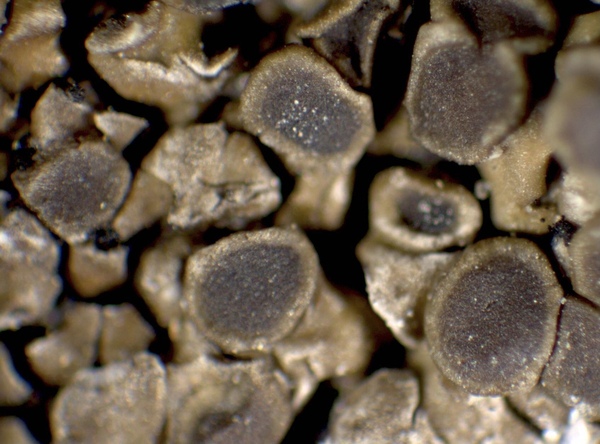Protoparmelia montagnei (Fr.) Poelt & Nimis
in Nimis & Poelt, Studia Geobot., 7, suppl. 1: 188, 1987. Basionym: Parmelia montagnei Fr. - Lichenogr. Eur. Ref.: 107, 1831.
Synonyms: Lecanora badia var. microcarpa Anzi?; Lecanora bagliettoana Jatta?; Lecanora fuscopallens (Kremp.) Zahlbr.; Lecanora montagnei (Fr.) Schaer.; Lecanora psarophana Nyl.; Lecanora psarophana var. aquilina Clauzade & Cl. Roux; Lecanora psarophana var. pallida (Wedd.) Harm.; Lecanora stenospora Hue in Maheu & A. Gillet; Lecanora verruculosa Bagl.?; Protoparmelia psarophana (Nyl.) Sancho & A. Crespo; Solenopsora montagnei (Fr.) M. Choisy & Werner; Solenopsora psarophana (Nyl.) M. Choisy & Werner
Distribution: N - Emil (Fariselli & al. 2020). C - Tosc, Laz, Sar (Monte 1993, Rizzi & al. 2011, Brackel & Berger 2019). S - Camp (Aprile & al. 2002), Bas (Puntillo & al. 2012), Cal (Puntillo 1996), Si (Ottonello & Puntillo 1995, Nimis & al. 1996b, Grillo 1998, Grillo & Caniglia 2004).
Description: Thallus crustose, episubstratic, continuous to areolate-subsquamulose, rather thick, chestnut-brown, pale reddish brown, rarely pale grey or olivaceous, frequently with poorly developed marginal lobes, often delimited by a black prothallus (especially when young). Areoles, when well-developed, irregularly polygonal to round, 0.2-2.5 mm wide, flat to convex, smooth to coarsely warted, the marginal ones often elongated and lobe-like. Cortex 20-30(-40) µm thick, composed of anticlinally arranged hyphae with brown-pigmented caps, sometimes inspersed with small, brown crystals dissolving in K (lobaric acid), or minute crystals of gyrophoric and lecanoric acids; epinecral layer usually well-developed, hyaline, (5-)10-15(-25) µm thick; medulla white, often with crystals, I-. Apothecia lecanorine, adnate to sessile and constricted at base, round to subangular, (0.5-)0.75-1.75(-2.5) mm across, with a brown to brownish black, concave to convex, epruinose disc and a slightly paler, thick, entire or crenulate, shiny, usually persistent thalline margin. Thalline exciple (50-)100(-200) μm wide, corticate, with a distinct medulla filled with algal cells; proper exciple forming a up to 100 µm thick cupular layer below the hypothecium; epithecium brown, 20-30 µm thick; hymenium colourless or yellowish, (50-)60-70(-90) µm high; paraphyses coherent in water, distinct in K, c. 2-2.5 μm thick at mid-level, with slightly wider apical cells covered by a swollen gelatinous hood; hypothecium colourless or pale yellow, up to 100 μm high. Asci 8-spored, clavate, approaching the Lecanora-type, with a well-developed amyloid tholus and a distinct, non-amyloid axial mass. Ascospores 1-celled, hyaline, oblong-ellipsoid to narrowly ellipsoid with rounded ends, thin-walled, (7.5-)9.5-13(-16) x (2.5-)3-4(-4.5) µm, with 2-3(-6), very thin, hyaline setae at each end. Pycnidia usually abundant, globose to oblong, the ostiole dark brown to black. Conidia simple, bacilliform, straight to slightly curved, (5-)7-11(-14) µm long. Photobiont chlorococcoid. Spot tests: medulla K+ pale to dirty yellow, C- or C+ pink to red, KC- or KC+ red to violet, UV+ white, or UV-; brown pigment in cortex, pycnidial wall around the ostiole and epithecium C+ fleeting bluish-grey, followed by very pale pink, K+ yellowish-brown. Chemistry: several chemotypes with lobaric acid (and several related substances), gyrophoric acid, lecanoric acid, and several fatty acids. Note: a Mediterranean-Macaronesian, chemically variable species found on siliceous rocks at relatively low altitudes. For further details see Barbero & al. (2006) and Singh & al. (2015).
Growth form: Crustose
Substrata: rocks
Photobiont: green algae other than Trentepohlia
Reproductive strategy: mainly sexual
Taxon bound to maritime-coastal situations
Commonnes-rarity: (info)
Alpine belt: absent
Subalpine belt: absent
Oromediterranean belt: absent
Montane belt: absent
Submediterranean belt: absent
Padanian area: absent
Humid submediterranean belt: rather common
Humid mediterranean belt: common
Dry mediterranean belt: rather common
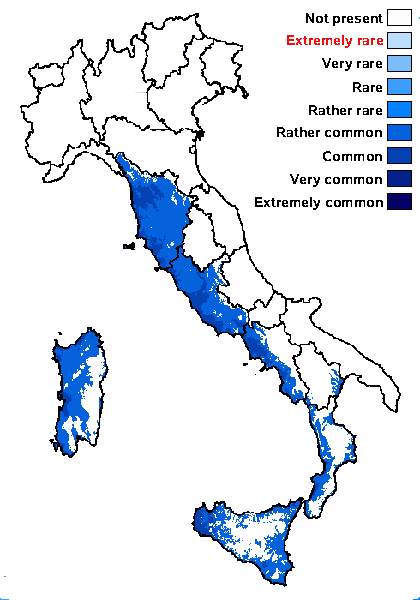
Predictive model
Herbarium samples
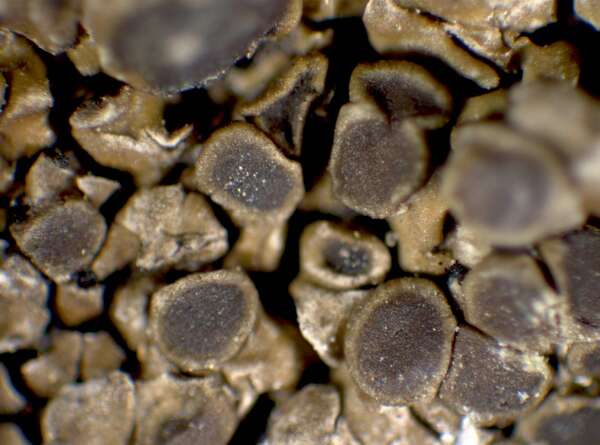

P.L. Nimis; Owner: Department of Life Sciences, University of Trieste
Herbarium: TSB (19381)
2001/11/29
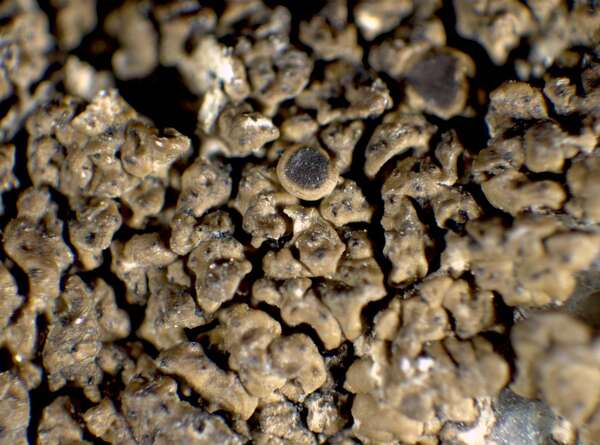

P.L. Nimis; Owner: Department of Life Sciences, University of Trieste
Herbarium: TSB (5985)
2001/11/29
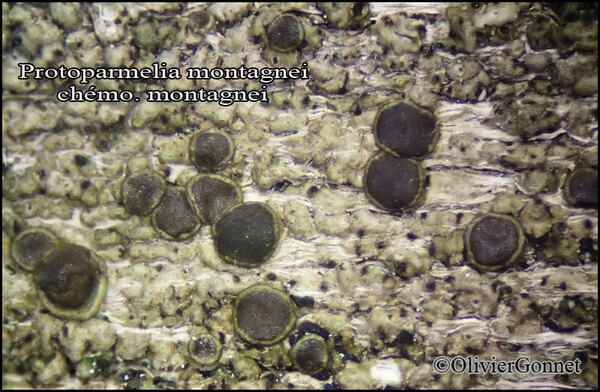
Courtesy Danièle et Olivier Gonnet - Source: https://www.afl-lichenologie.fr/Photos_AFL/Photos_AFL_P/Text_P/Protoparmelia_montagnei.htm
France, 18/10/2018 - sur piquet en châtaignier - Ajaccio - Corse
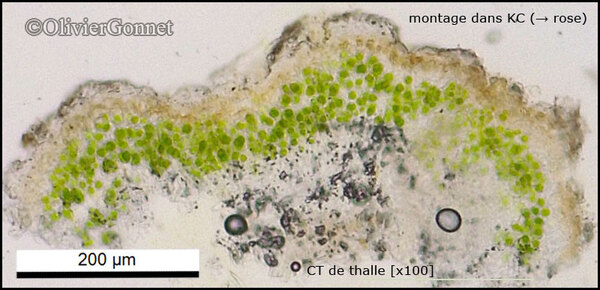
Courtesy Danièle et Olivier Gonnet - Source: https://www.afl-lichenologie.fr/Photos_AFL/Photos_AFL_P/Text_P/Protoparmelia_montagnei.htm
France, 18/10/2018 - sur piquet en châtaignier - Ajaccio - Corse
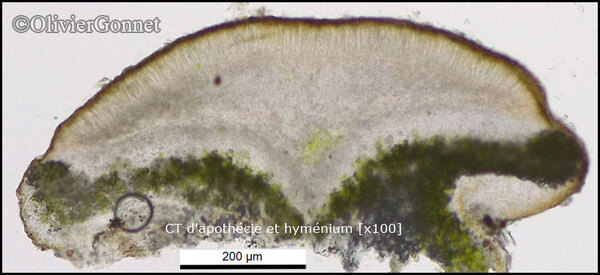
Courtesy Danièle et Olivier Gonnet - Source: https://www.afl-lichenologie.fr/Photos_AFL/Photos_AFL_P/Text_P/Protoparmelia_montagnei.htm
France, 18/10/2018 - sur piquet en châtaignier - Ajaccio - Corse
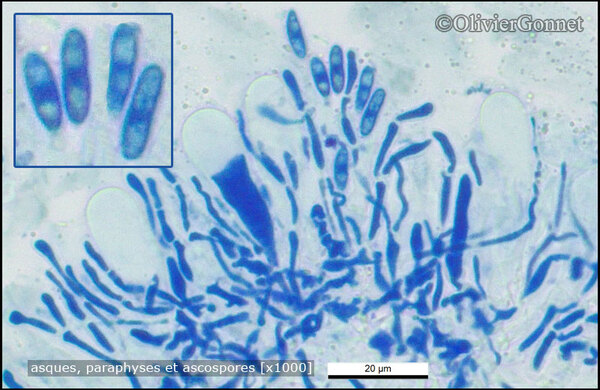
Courtesy Danièle et Olivier Gonnet - Source: https://www.afl-lichenologie.fr/Photos_AFL/Photos_AFL_P/Text_P/Protoparmelia_montagnei.htm
France, 18/10/2018 - sur piquet en châtaignier - Ajaccio - Corse

Courtesy Danièle et Olivier Gonnet - Source: https://www.afl-lichenologie.fr/Photos_AFL/Photos_AFL_P/Text_P/Protoparmelia_montagnei.htm
France, 18/10/2018 - sur piquet en châtaignier - Ajaccio - Corse
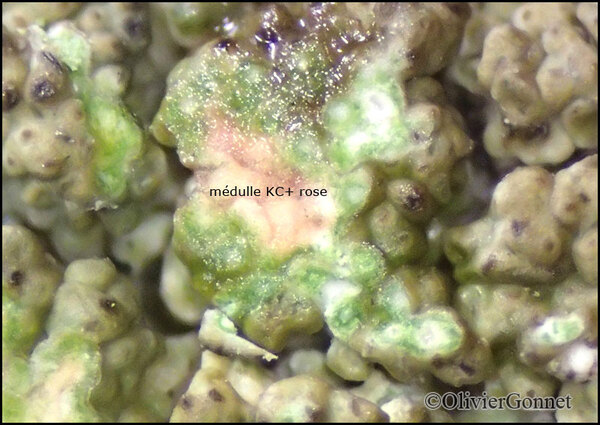
Courtesy Danièle et Olivier Gonnet - Source: https://www.afl-lichenologie.fr/Photos_AFL/Photos_AFL_P/Text_P/Protoparmelia_montagnei.htm
France, 18/10/2018 - sur piquet en châtaignier - Ajaccio - Corse
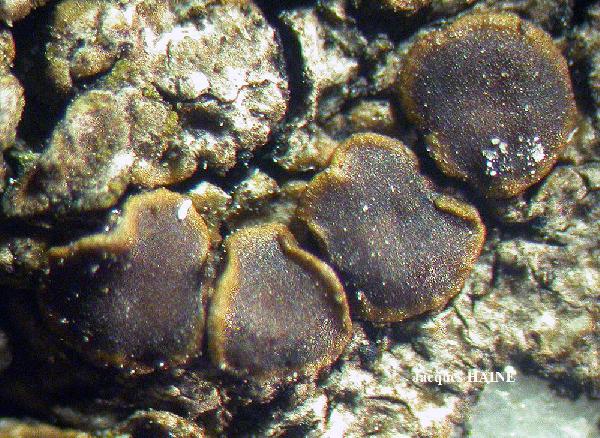
Jacques Haine - Source: http://www.lichensmaritimes.org/index.php?task=fiche&lichen=47&lang=en
France, Pointe de Dinan
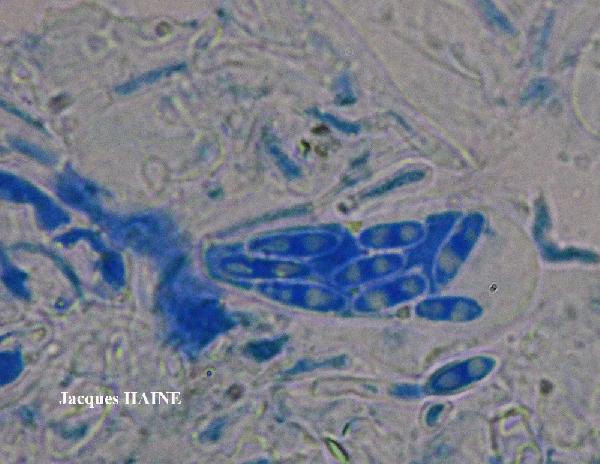
Jacques Haine - Source: http://www.lichensmaritimes.org/index.php?task=fiche&lichen=47&lang=en
France, Pointe de Dinan
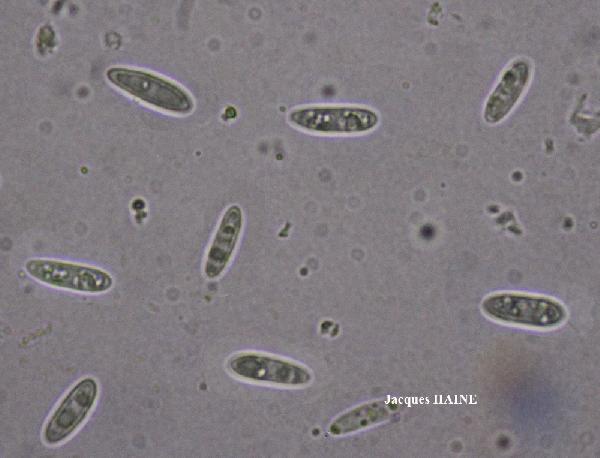
Jacques Haine - Source: http://www.lichensmaritimes.org/index.php?task=fiche&lichen=47&lang=en
France, Pointe de Dinan
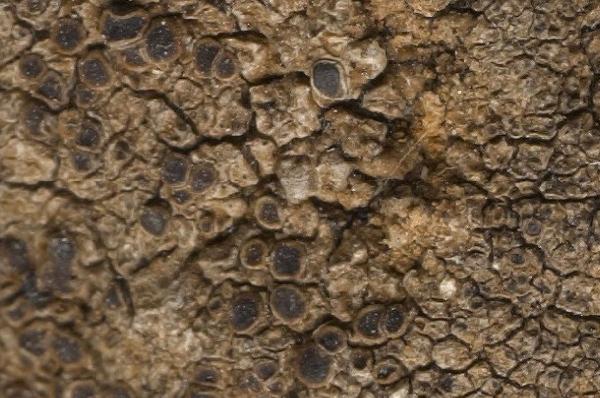
Detail from: https://gzu.jacq.org/GZU000290849
GZU000290849 as Lecanora psarophana var. aquilina (isotype) - Cl. Roux - Date 1976-07-10
Location France / Rhone-Alpes
Label Francio, Provenco, Bouches-du-Rhône, la Ciotat, golfeto de Figuerolles, sur apudmara krutajo NNW-orientiga ; Alt. 10 m
Habitat sur apudmara krutajo NNW-orientiga, el turonia pudingo (stonoj el nekalka, kvarcita grejso; cementjo apenau kalka).
Habitus
Annotations GZU Inv.-Nr. 110-86
K: Girofora acido
Growth form: Crustose
Substrata: rocks
Photobiont: green algae other than Trentepohlia
Reproductive strategy: mainly sexual
Taxon bound to maritime-coastal situations
Commonnes-rarity: (info)
Alpine belt: absent
Subalpine belt: absent
Oromediterranean belt: absent
Montane belt: absent
Submediterranean belt: absent
Padanian area: absent
Humid submediterranean belt: rather common
Humid mediterranean belt: common
Dry mediterranean belt: rather common

Predictive model
| Herbarium samples |


P.L. Nimis; Owner: Department of Life Sciences, University of Trieste
Herbarium: TSB (19381)
2001/11/29


P.L. Nimis; Owner: Department of Life Sciences, University of Trieste
Herbarium: TSB (5985)
2001/11/29

Courtesy Danièle et Olivier Gonnet - Source: https://www.afl-lichenologie.fr/Photos_AFL/Photos_AFL_P/Text_P/Protoparmelia_montagnei.htm
France, 18/10/2018 - sur piquet en châtaignier - Ajaccio - Corse

Courtesy Danièle et Olivier Gonnet - Source: https://www.afl-lichenologie.fr/Photos_AFL/Photos_AFL_P/Text_P/Protoparmelia_montagnei.htm
France, 18/10/2018 - sur piquet en châtaignier - Ajaccio - Corse

Courtesy Danièle et Olivier Gonnet - Source: https://www.afl-lichenologie.fr/Photos_AFL/Photos_AFL_P/Text_P/Protoparmelia_montagnei.htm
France, 18/10/2018 - sur piquet en châtaignier - Ajaccio - Corse

Courtesy Danièle et Olivier Gonnet - Source: https://www.afl-lichenologie.fr/Photos_AFL/Photos_AFL_P/Text_P/Protoparmelia_montagnei.htm
France, 18/10/2018 - sur piquet en châtaignier - Ajaccio - Corse

Courtesy Danièle et Olivier Gonnet - Source: https://www.afl-lichenologie.fr/Photos_AFL/Photos_AFL_P/Text_P/Protoparmelia_montagnei.htm
France, 18/10/2018 - sur piquet en châtaignier - Ajaccio - Corse

Courtesy Danièle et Olivier Gonnet - Source: https://www.afl-lichenologie.fr/Photos_AFL/Photos_AFL_P/Text_P/Protoparmelia_montagnei.htm
France, 18/10/2018 - sur piquet en châtaignier - Ajaccio - Corse

Jacques Haine - Source: http://www.lichensmaritimes.org/index.php?task=fiche&lichen=47&lang=en
France, Pointe de Dinan

Jacques Haine - Source: http://www.lichensmaritimes.org/index.php?task=fiche&lichen=47&lang=en
France, Pointe de Dinan

Jacques Haine - Source: http://www.lichensmaritimes.org/index.php?task=fiche&lichen=47&lang=en
France, Pointe de Dinan

 INDEX FUNGORUM
INDEX FUNGORUM
 GBIF
GBIF
 DOLICHENS
DOLICHENS
